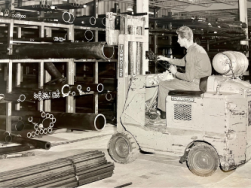State of Steel - August 2022
Pricing - Why is some steel decreasing while others are remaining flat?
Steel tube pricing continues to be conflicting and confusing. In light of the CRU index precipitously dropping over the last few months, we have seen structural tube prices go down while mechanical tube prices continue to remain high. Due to the CRU index hitting a new 2-year low of $832 per ton, structural tubing prices (which is made directly from coil) have continued to decrease since the beginning of June. Nucor Tubular, Atlas Tube, and most other structural tube mills have notified customers of a $100/ton decrease in hollow structural section (HSS) prices on August 4th.
While structural tube pricing declines, mechanical tubing pricing remains flat and lead times continue to be very long. Mechanical tubing (DOM, HRS, CDS) mills are struggling to keep up with demand due to labor shortages, strong demand, and a limited supply of tube hollows and bar. Because of these factors, the pricing looks to continue to stay quite high by remaining flat. Most lead times for hot rolled seamless, cold drawn seamless, and drawn over mandrel tubing are well into next year! The below charts reflect the CRU index, and a current listing of all price increases/decreases on tubing that we have seen since late August of 2020.
Effective August 8th, 2022, Nucor announced a $50/ton increase on all base prices for any new orders for sheet and coil. Whether this will stick, and others will follow is yet to be determined. On the flip side, Nucor announced it reduced plate prices by $120/ton for all new orders received as of July 28. (Source: Platts)



Cast Iron Pricing
August did not see any base increases for cast iron. Since January of 2021, Dura-Bar has increased their base prices a total of 5 times. Surcharges appear to have topped out in May as we have now seen surcharge decreases two months in a row. Assuming Dura-Bar does not increase their base pricing again, we should continue to see some relief in pricing based on surcharges declining. The below chart details the Dura-Bar surcharges over the last year or so.

Scrap & Steel Inputs
Detroit mills kicked off the August scrap trade by offering to buy prime scrap at a $70/ton month-over-month decline and shredded scrap at $20/ton month-over-month decline. If the offers by the Detroit mills hold this will mark the fourth consecutive monthly decline in scrap prices, and it will bring prime scrap prices below shredded scrap prices. (Source: AMM)
Metal Production
In the week ended July 30, US raw steel production decreased 1.5% week-over-week to 1,727,000 tons (-7.3% YoY). US capacity utilization was 78.4% vs 84.4% last year. This marks the lowest weekly capacity utilization since May 2021 and the lowest weekly production since February 2021. Year-to-date production is 52,747,000 tons which is down 2.9% year-over-year. (Source: AISI)
Lead Times
Understanding lead times for steel products are important to every participant in the supply chain. Lead times for steel products are as follows (as of 08/09/22):
Average HRC lead times were flat last week at 5.0 weeks, which is below the average of 5.6 weeks since 2016. Other product lead times were flat to longer last week with CRC lead times at 6.2 weeks, HDG lead times at 6.6 weeks, and plate lead times at 5.1 weeks. (Source: Platts)
DOM, HRS, and CDS Tubing lead times continue to be very long and are anywhere from 30 to 45 weeks primarily now due to backlog and labor shortages. We continue to see lead times be long and are now seeing availability not free up until early to mid-2023.
Structural Tubing mill lead times are steady and running approximately 3-4 weeks upon receipt of order. Common sizes we can get sooner for now.
Dura-Bar Continuous Cast Iron mill lead times are approximately 8-14 weeks depending on size, grade, and finish. If it’s a large bar, special grade, size, or shape then the lead time could be considerably longer. We are currently struggling to inventory large gray iron billets for our plate department but are looking to resolve as best we can. We are experiencing longer lead times for round bars under 2” diameter and above 10” diameter.
Oil & Gas Industry
The US rig count increased 1.2% week-over-week to 767 rigs as of 7/29. The rig count is up 57.2% year-over-year. (Source: Baker Hughes) Russia announced it is suspending crude oil exports through its Druzhba pipeline, leading to price increases. The move cuts off the flow of oil to Hungary, Slovakia, and the Czech Republic. Soon after the announcement that the Ukrainian part of the pipeline would be halted, crude oil prices jumped, with Brent crude increasing 1.36% to nearly $98 a barrel, Insider reported. WTI crude went up 1.22%, reaching almost $92 a barrel. (Source: Fox Business)
Economic Factors
Market participants report that HRC buying activity has picked up modestly with mills close to selling all their expected August production. However, service centers generally remain in a destocking mode and are purchasing opportunistically. (Source: AMM)
The US Federal Reserve raised interest rates by 75 basis points for the second consecutive meeting, taking its benchmark rate to a range of 2.25%-2.5%. (Source: CNBC)
The economy shrank for a second consecutive quarter, with US GDP declining by 0.9% during the second quarter, which was worse than analyst estimates of a 0.3% gain. That follows a 1.6% decline in the first quarter. Two consecutive quarterly declines in GDP traditionally implies a recession. The decline came from a broad swath of factors, including decreases in inventories, residential and nonresidential investment, and government spending. (Source: CNBC)
Despite some robust hiring in 2021 and earlier this year, there are still 755 thousand fewer Americans employed today than there were in February 2020, the last month before the Covid pandemic hit. (Source: CNBC)
Imports/Exports
Based on preliminary Census Bureau data, the American Iron and Steel Institute (AISI) reported today that the U.S. imported a total of 2,810,000 net tons (NT) of steel in June 2022, including 2,204,000 net tons (NT) of finished steel (up 2.3% and down 6.0%, respectively, vs. May 2022). Total and finished steel imports are up 14.3% and 34.7%, respectively, year-to-date vs. 2021. Over the 12-month period, July 2021 to June 2022, total and finished steel imports are up 38.2% and 50.1%, respectively, vs. the prior 12-month period. (Source: American Iron and Steel Institute)







